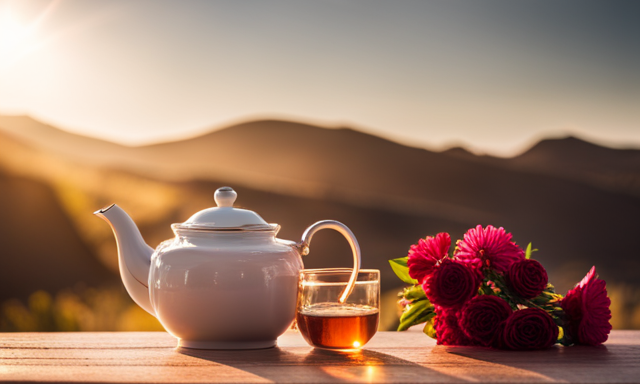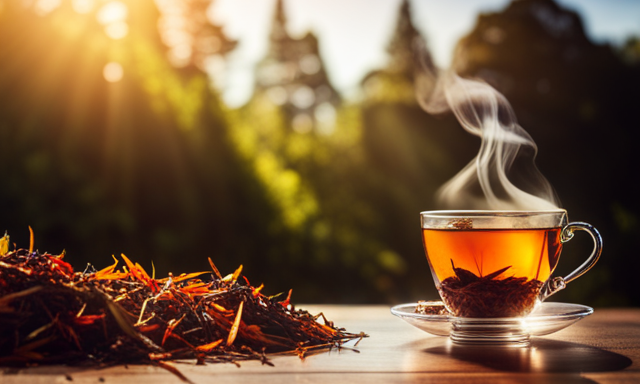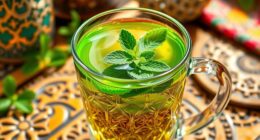Did you know that rooibos tea, one of the most popular herbal teas in the world, originates from a small region in South Africa? It’s true! With its unique flavor and numerous health benefits, rooibos tea has captivated tea enthusiasts worldwide.
In this article, I will take you on a journey to discover the rich history and origins of this remarkable beverage. We will delve into the traditional use of rooibos by the indigenous people of South Africa and explore how European explorers stumbled upon this hidden gem.
Additionally, we will uncover the fascinating process of cultivating and commercializing rooibos tea, as well as the sustainable farming practices and fair trade initiatives that have made it a beloved choice for conscious consumers.
Join me as we explore the origins, production, and health benefits of rooibos tea, and embrace this delightful beverage that has stood the test of time.
Key Takeaways
- Rooibos tea is exclusively from the Cederberg region of South Africa and has a long and cherished history.
- The sourcing of Rooibos tea prioritizes sustainable farming practices, such as organic cultivation, crop rotation, and water conservation.
- Fair trade initiatives in the Rooibos tea industry ensure fair wages, better working conditions, and support for local communities in terms of education, healthcare, and infrastructure development.
- Rooibos tea is popular in the culinary and wellness industries due to its versatility in recipes, antioxidant properties, and infusion into skincare and beauty products.
The Origins of Rooibos Tea in South Africa
You may be surprised to learn that the origins of rooibos tea can be traced back to the beautiful landscapes of South Africa. The indigenous people of this region, known as the Khoi and San, have been using rooibos for centuries due to its abundance and various health benefits.
Rooibos tea has a rich historical significance as it was traditionally used by these native communities for its medicinal properties and as a refreshing beverage. The Khoi and San would harvest the leaves, ferment them, and then brew a flavorful tea.
Today, rooibos tea remains an integral part of South African culture and is enjoyed worldwide for its unique taste and numerous health benefits.
Now, let’s explore the indigenous people and their traditional use of rooibos.
The Indigenous People and Their Traditional Use of Rooibos
Discover the rich cultural heritage of the indigenous people and their time-honored practices in utilizing this unique South African plant.
Rooibos tea has been a part of indigenous traditions for centuries, with deep cultural significance. The Khoisan people, in particular, have a strong connection to the rooibos plant and have used it for medicinal and culinary purposes. They would harvest the leaves and stems, ferment them, and then dry them in the sun to create the vibrant red tea we know today. The indigenous people also believed that rooibos had healing properties and used it to treat various ailments. This tradition has been passed down through generations and is still an important part of their cultural identity.
Transitioning into the next section, European explorers stumbled upon this fascinating plant during their voyages of discovery.
The Discovery of Rooibos by European Explorers
Take a journey back in time and imagine being one of the European explorers who stumbled upon the vibrant red beverage, which eventually gained popularity worldwide, with over 15,000 tons exported annually. During the 17th century, European explorers, particularly the Dutch, began to explore the Cape of Good Hope in South Africa. It was during these expeditions that they encountered the indigenous Khoi and San people who were drinking a unique red tea made from the leaves of the rooibos plant. The Europeans were fascinated by this new discovery and quickly recognized its cultural significance. They observed the Khoi and San people using rooibos tea for various purposes, including medicinal and ceremonial practices. This encounter marked the beginning of the cultivation and commercialization of rooibos tea, which would soon spread throughout Europe and beyond. Transitioning into the subsequent section, the demand for rooibos tea led to its cultivation and commercialization on a larger scale.
The Cultivation and Commercialization of Rooibos Tea
Imagine being one of the European explorers who stumbled upon the vibrant red beverage and now witness the cultivation and commercialization of this unique drink on a larger scale. Rooibos tea, originating from the Cederberg region in South Africa, has gained popularity worldwide due to its distinct flavor and numerous health benefits.
To meet the growing demand, cultivation techniques have been refined over the years, ensuring consistent quality and sustainability. Farmers have perfected the art of growing rooibos, carefully selecting the best seeds and employing organic farming methods. In addition, market trends have shown an increasing preference for organic and fair trade products, leading to the rise of certified rooibos tea.
This delicious drink is now enjoyed by people around the globe, from tea enthusiasts to health-conscious individuals.
Transitioning to the subsequent section about the health benefits of rooibos tea, let’s explore how this beverage can positively impact your well-being.
The Health Benefits of Rooibos Tea
You won’t believe the incredible way this vibrant red elixir can transform your well-being, leaving you feeling healthier and more energized than ever before.
Rooibos tea is not only a delicious beverage, but it also boasts numerous health benefits. One of the key benefits is its high antioxidant properties. Rooibos tea is packed with powerful antioxidants that can help fight against free radicals in the body, reducing the risk of oxidative stress and inflammation.
These antioxidants have been linked to potential roles in preventing chronic diseases such as heart disease, diabetes, and certain types of cancer. With its potent health benefits, it’s no wonder that rooibos tea has gained global popularity.
Now, let’s delve into how this amazing tea has captured the attention of tea enthusiasts worldwide.
The Global Popularity of Rooibos Tea
Rooibos tea’s worldwide popularity is a testament to its incredible ability to captivate tea enthusiasts everywhere. This unique tea has gained a strong foothold in the global market, with its popularity extending far beyond its native South Africa. Its distinct flavor and numerous health benefits have made it a favorite among tea lovers around the world.
Additionally, rooibos tea holds cultural significance in many countries, particularly in South Africa where it has been enjoyed for centuries. Its rise to fame can be attributed to its rich history and the efforts of dedicated tea connoisseurs who’ve introduced it to new markets.
As we delve into the next section about rooibos tea production and processing, we’ll explore the fascinating journey from plant to cup.
Rooibos Tea Production and Processing
When it comes to the production and processing of Rooibos tea, two key steps are involved: harvesting and fermentation, and drying and packaging.
Harvesting is typically done by hand, where skilled workers carefully select the leaves and stems from the Rooibos plant.
After harvesting, the leaves and stems undergo a fermentation process, where they’re left to oxidize for a specific period of time, which gives the tea its distinct flavor and color.
Once fermentation is complete, the Rooibos tea is then dried and carefully packaged to preserve its freshness and quality.
Harvesting and Fermentation
During the harvesting and fermentation process, the leaves of the rooibos plant undergo a transformation that brings out its unique flavor profile. The fermentation process is a crucial step in the production of rooibos tea, as it allows for the development of its distinct taste and aroma.
Traditionally, the leaves are harvested by hand, using traditional techniques that’ve been passed down through generations. This ensures that only the highest quality leaves are selected for processing. After harvesting, the leaves are then carefully fermented, which involves allowing them to oxidize in the presence of moisture. This fermentation process is what gives rooibos tea its characteristic reddish-brown color and rich, earthy flavor.
Once the fermentation is complete, the leaves are ready for the next stage of production: drying and packaging. This step further enhances the flavor and aroma of the tea, preparing it for consumption.
Drying and Packaging
After the fermentation process, how do the leaves of the rooibos plant go from moist and oxidized to dry and ready for packaging?
The drying process is crucial in preserving the flavor and quality of rooibos tea. Traditionally, rooibos leaves were dried under the African sun, but modern techniques have introduced more efficient drying methods.
One common technique is to place the leaves in large drying beds or racks, where hot air is circulated to remove moisture. Some farmers also use drying machines that blow warm air onto the leaves, speeding up the process.
Another innovation is the use of vacuum drying, which helps retain the tea’s natural flavors and aromas.
Once dried, the leaves are carefully inspected for quality and then packaged in airtight containers to maintain freshness.
Now, let’s explore how sustainable farming practices and fair trade initiatives have transformed the rooibos tea industry.
Sustainable Farming Practices and Fair Trade Initiatives
Rooibos tea is sourced from regions that prioritize sustainable farming practices and fair trade initiatives, ensuring that every sip supports ethical and responsible production. Sustainable farming practices such as organic cultivation, crop rotation, and water conservation are employed to minimize the environmental impact of rooibos cultivation.
Farmers also prioritize fair trade initiatives, which aim to provide fair wages and better working conditions for workers. These initiatives empower local communities by supporting education, healthcare, and infrastructure development.
By embracing sustainable farming practices and fair trade initiatives, rooibos tea producers contribute to the preservation of the natural environment and the well-being of the communities involved in its production. These efforts not only result in a high-quality product but also resonate with consumers who value ethical and responsible sourcing.
As a result, rooibos tea has gained popularity in the culinary and wellness industries, where it’s used in various recipes and recognized for its health benefits.
Rooibos Tea in Culinary and Wellness Industries
Rooibos tea has gained popularity not only as a beverage but also as an ingredient in various recipes and beverages. Its unique flavor and health benefits make it a versatile ingredient that can be used in both sweet and savory dishes.
Additionally, rooibos tea has found its way into the skincare and beauty industries, with many products incorporating its antioxidant properties for a natural and nourishing effect on the skin.
Rooibos-infused Recipes and Beverages
Incorporating rooibos tea into your favorite recipes and beverages adds a vibrant and flavorful twist. The versatility of rooibos allows it to be infused into a variety of culinary creations, from refreshing cocktails to indulgent desserts.
For a unique twist on a classic cocktail, try a rooibos-infused mojito or a rooibos tea-infused gin and tonic. The earthy and slightly sweet flavors of rooibos add depth and complexity to these drinks.
In the realm of desserts, rooibos can be used to infuse custards, ice creams, and even baked goods like cookies and cakes. The natural sweetness of rooibos pairs perfectly with rich and creamy desserts, creating a delightful balance of flavors.
With its numerous applications in the culinary world, rooibos tea truly shines as a versatile ingredient.
Moving on to rooibos tea in skincare and beauty products…
Rooibos Tea in Skincare and Beauty Products
Discover how using rooibos-infused skincare and beauty products can nourish and revitalize your skin, leaving you feeling as radiant as a summer sunset. Rooibos tea, known for its numerous health benefits, is also a star ingredient in natural skincare.
Packed with antioxidants, rooibos tea helps protect the skin from free radicals that can cause premature aging. Its anti-inflammatory properties soothe irritated skin and reduce redness, making it perfect for those with sensitive skin. Rooibos tea is also rich in alpha hydroxy acids, which gently exfoliate and brighten the skin, revealing a youthful glow.
Whether it’s a rooibos-infused face mask, moisturizer, or toner, incorporating this powerful ingredient into your skincare routine can provide numerous benefits for your skin. Transitioning into the subsequent section, embracing the rich history and health benefits of rooibos tea, will further enhance your overall well-being.
Conclusion: Embracing the Rich History and Health Benefits of Rooibos Tea
To truly appreciate the rich history and health benefits of Rooibos tea, you should take a moment to consider its origins and how it has been enjoyed for centuries. Rooibos tea has a long and storied tradition in South Africa, where it’s grown exclusively in the Cederberg region.
The local indigenous people, known as the Khoisans, were the first to discover the unique properties of this tea and have been embracing its tradition for generations.
One of the most remarkable aspects of Rooibos tea is its numerous health benefits. It’s packed with antioxidants, minerals, and vitamins, making it known to boost the immune system, improve digestion, and promote healthy skin. Its anti-inflammatory properties have also been linked to reduced risk of chronic diseases and improved heart health. Moreover, Rooibos tea is caffeine-free, making it a perfect choice for those looking for a soothing and calming beverage.
In conclusion, Rooibos tea has a long and cherished history, and its health benefits are undeniable. By embracing this tradition and incorporating it into our daily lives, we can experience the richness and goodness that Rooibos tea has to offer.
Frequently Asked Questions
How is rooibos tea different from other types of tea?
Rooibos tea, unlike other teas, is just a flavorless, boring drink. It offers no health benefits and has no unique flavor profiles like other teas do. It’s basically just a waste of time.
Are there any side effects or potential risks associated with drinking rooibos tea?
There are no known side effects or potential risks associated with drinking rooibos tea. It is known for its potential health benefits and can be consumed according to recommended guidelines.
Can rooibos tea be consumed by pregnant women or children?
Rooibos tea is safe for pregnant women and children to consume. It has no caffeine and is rich in antioxidants, making it a healthy choice. Additionally, it can be beneficial for breastfeeding women as it may improve milk production.
Is rooibos tea caffeine-free?
Yes, rooibos tea is caffeine-free. It is a great alternative to traditional tea for those looking to avoid caffeine. In addition, rooibos tea offers many health benefits, such as being rich in antioxidants and supporting heart health.
Can rooibos tea help with weight loss or managing diabetes?
Rooibos tea can help with weight loss and managing diabetes. It aids in weight loss by boosting metabolism and reducing hunger cravings. It also regulates blood sugar levels, making it beneficial for diabetes management.
Conclusion
As I conclude this exploration of the rich and fascinating history of Rooibos tea, I’m left in awe of its origins and the journey it’s taken to become the beloved beverage it is today. From its discovery by European explorers to its cultivation and commercialization, Rooibos tea has captured the hearts and taste buds of people around the world.
But the story doesn’t end there. With its numerous health benefits and its place in culinary and wellness industries, Rooibos tea continues to enchant and inspire. So, as you sip on your next cup of Rooibos tea, remember the incredible journey it has taken, and let its tantalizing taste and healthful properties transport you to the sun-drenched landscapes of South Africa.










